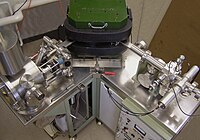
Photo from wikipedia
Quantitative analytical approaches for isotopic niche analysis in the trophic diversity studies are proliferating rapidly; however, the assumptions behind the isotopic niche applications are rarely tested. One of the main… Click to show full abstract
Quantitative analytical approaches for isotopic niche analysis in the trophic diversity studies are proliferating rapidly; however, the assumptions behind the isotopic niche applications are rarely tested. One of the main assumptions is independence of the niche metrics and physiological status of the animals. The aim of this experimental study was to test the relationship between growth and Layman's metrics of isotopic niche in consumers eating the same food but in different quantities and growing at different rates. Based on research indicating that individual variability in isotopic fractionation increases under suboptimal conditions, I hypothesized that a group of consumers originating from the same population and exposed to food limitation would have greater estimates of the niche breadth and diversity as a result of higher inter-individual variability in growth rate and stable isotope signatures than in non-limiting feeding conditions. This hypothesis was tested using Baltic mysids Neomysis integer fed isotopically uniform diet under laboratory conditions and analyzing individual growth and stable isotope signature in concert. As hypothesized, mysid growth rate was a significant negative predictor of most niche metrics. These effects were related to both increased inter-individual variability and higher trophic fractionation in malnourished animals, whereas in actively growing mysids lower fractionation was observed together with lower values for niche size, isotopic range and trophic diversity. These findings challenge how we interpret the intrapopulation isotopic variance and evaluate isotopic evidence of individual specialization and call for integrated approaches for isotopic niche and growth assessment. This article is protected by copyright. All rights reserved.
Journal Title: Methods in Ecology and Evolution
Year Published: 2017
Link to full text (if available)
Share on Social Media: Sign Up to like & get
recommendations!